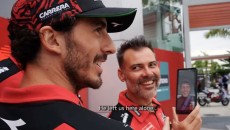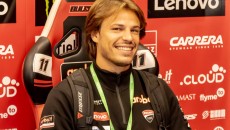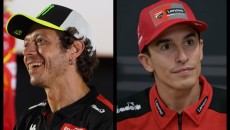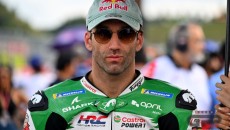Since the good old dean Paolo Scalera enjoys making videos sitting in his nice chair, I thought I would imitate him and do something like that myself. Let's say that he always chooses current topics, while today I want to go back a little bit into the past and tell you a story. I am talking about the 2002 Mundialito, the famous "Pizza Mundialito."
Why? Because a few days ago, during our Bar Sport programme, Carlo Pernat recalled that battle between Valentino Rossi and Alex Barros. Both raced with Honda in 2002: Barros, however, for almost the entire season, rode an old NSR 500, while Valentino, as it was the first year of the four-strokes, had the new RC211V. In the last four races of the championship, however, Valentino challenged Barros "on equal bikes" to decide who was the best.
This situation, in my opinion, is partly reminiscent of what we might experience between now and the end of the 2025 season between Marc Márquez and Pecco Bagnaia: a kind of year-end Mundialito. Because Pecco seems to have rediscovered his total feeling with the Ducati, he dominated at Motegi, and it will be curious to see if from here to Valencia he can really fight on equal terms with Márquez. True, the bikes have been identical from the start, there were no technical differences as there were in 2002, but Bagnaia had so far never been able to get the most out of his Desmosedici. Now, with a few changes on his GP25 (what exactly?) things could get back to be balanced and finally give us that duel at the top we've all been waiting for since the beginning of the year.
But let's go back to that 2002 season. Not everyone knows the background of this story, so let's go in order. It was the first season of MotoGP, the debut of four-strokes in the world championship. Honda surprised everyone with a jewel: the RC211V, a spectacular five-cylinder. Valentino always called it a piece of jewelry, not least because of the special exhaust that went around the bank: beautiful to look at and very fast on the track. So fast that it allowed him to win 10 of the first 12 races. His only faux pas were a second-place finish at Welkom, where he was beaten by teammate Ukawa, and a retirement due to tyre problems at Brno, where Max Biaggi won.
In essence, up to that point Valentino had dominated the championship. But for the last four races Honda decided to give another RC211V to the Pons team. First it had given it to the Gresini team, replacing Daijiro Kato's 500, then it was the turn of Sito Pons' team that was racing Barros and Capirossi.
Why was it Barros who received it and not Capirossi? Carlo Pernat explained it well. Already in July it was known that Honda would give only one RC211V to the Pons team, so the choice was between Loris and Alex. Loris wanted it badly, but at that time his contract was expiring and he was already negotiating with Ducati, which had just announced its entry into MotoGP. There were other options as well; Kawasaki, for example, made Capirossi a million-dollar offer. In the end, however, he signed for Ducati in August, which preferred him to Biaggi and Barros himself. At that point it was inevitable that Honda would hand over the new bike to Barros, who was still free. A logical decision, even if Capirossi was disappointed: with the old NSR500 he still managed to bring home podiums, albeit with a gap of several horsepower.
Thanks to Pernat, then, we have a clear picture. Barros took the RC211V and in those last four races challenged Rossi on equal terms. And he started out great right away: on his debut with the new bike, at Motegi (then the Pacific GP, because the Japanese GP was held at Suzuka), Barros won by beating Valentino. It should be remembered that in that race Capirossi, third with the old 500, also did a major feat, spurred on by anger at not getting the new Honda. The first laps were epic, with Loris attempting to hold off the four-strokes despite having an outdated machine.
The second leg was at Sepang: there Biaggi won ahead of Rossi, with Barros third. The third was at Phillip Island, a track beloved by Valentino, who dominated by winning with a margin of more than nine seconds over Barros thanks to a mistake by the Brazilian at the hairpin. At that point, Rossi had a slight lead in the Mundialito.
So it came down to the showdown at Valencia: Barros beat Rossi by just two tenths and took the victory, also winning the Mundialito by a single point (86 to 85). It was quite a blow for Valentino, who for the first time saw himself beaten on the same bike.
That mini-series of races changed Barros' fate: he earned the Yamaha Factory seat for 2003, replacing Biaggi. Then there was the famous lawsuit with Altadis to dissolve the contract, with a million-dollar fine, in order to return to Honda when Rossi chose to go to Yamaha in turn. Honda thought they could replace Rossi with Barros without losing too much, but things did not turn out exactly that way.
In short, this is the story of the 2002 Mundialito: four races, a pizza up for grabs, and Rossi beaten by a whisker.
And now who knows: maybe in the 2025 season finale we will experience a "new Mundialito," this time between Marquez and Bagnaia. Marc has already won the world championship, but in the last races there will certainly be a lot of curiosity: will Pecco really manage to challenge him head-on? The betting is open.








